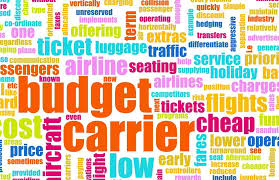The Effects of Low Cost Carriers in Europe and their impact on European Aviation Industry By Aaron Aristotle
|
|
|
The Effects of Low Cost
Carriers in Europe and their impact on European Aviation Industry
|
|
Introduction to Research Skills
|
|
|
|
Aaron Aristotle Hanafi
|
|
16065883@student.hhs.nl
|
Executive
summary
This report is written in order to
find, and investigate the impacts of low cost carriers in Europe. There has
been a growing concern in the European aviation industry concerning low-cost
carriers. The biggest concern was that they were so dominating all over Europe,
rendering full-fare airlines or mainline airlines irrelevant at times. As a
result, more and more people elected to travel with low-cost airlines because
of the low price. This leads to mainline-airlines struggling to cope with the
heavy presence of low-cost airlines. A prime example is that, in 2009, Alitalia
declared bankruptcy because of low-profits. This report will find how this
low-cost airlines affected the mainline airline operators, and also what
passengers think of low-cost airlines, this is to find out why they chose to fly
low cost carriers.
Table of Contents
Executive Summary…………………………………………………………………..2
Introduction and Methodology…………………………………………………4
Research findings………………………………………………………………………5-6
Analysis-Conclusion……………………………………………………………………6
Annotated Bibliography………………………………………………………………7
Introduction
To understand how low-cost airlines
affected European aviation industry; we must first define what airline actually
is. An airline is a company that
provides air transportation, both passengers and freight utilizing aircrafts. A
low cost carrier is an airline that provides air travels with a very low
prices, and few onboard comfort. To make up for the low prices that the
low-cost airline charge, the low cost airlines usually charges extra-prices for
onboard food, baggage.
In Europe, there are four low cost
carriers that dominate the airline market. These are the airlines
1. Ryanair (Dublin-based
Irish low cost carrier)
2. Easyjet (London based, British low-cost carrier)
3. Norwegian Air-Shuttle
(Oslo-based, Norwegian low-cost carrier)
4. Wizz Air (Budapest-based,
Hungarian low-cost carrier)
In Europe, the
low cost concept originates in the United Kingdom and Ireland, with the
introduction of Easyjet and Ryanair in 1995. Their success, along with two
other European low cost carriers mentioned above in the list, was encouraged by
the airline-deregulation act that was in effect in Europe, a legislation aimed
at dismantling government regulation of the airline industry. This leads to
this report’s main central question “What
is the impact of low-cost carriers on European aviation industry”. This is
also connected to the sub-questions:
1. What effects does low
cost carriers had that directly affected mainline operators (full-service
airlines)
2. What does the
expansion of low cost carriers in Europe have on traditional hub-spoke (home
airportsà destination airport) network
3. What is the passenger
perception of low cost carriers?
Methodology
To answer the questions that are
mentioned above, an extensive desk research was used, alongside multiple
sources that were found in the internet. All four questions are answered using
sources that are gathered in the internet. The sources are reports from the
IATA (International Air Transport Association), researches that’s been done
previously, and a report from the European Union on the growth of European
low-cost carriers. This sources is picked due to its un-doubted accuracy and
credibility
What
is the impact of low-cost carriers on European aviation industry?
The impact of low-cost carriers to
the European aviation industry has been tremendous. Firstly, the deep-market
penetration of these budget airlines has caused many mainline/full-service
airlines to suffer financial problems and low passenger numbers. This report
will be discussing more about the effects on the mainline operators on the
first sub-question. Low-cost airlines base their operations on constant
elimination of non-profitable lines and introduction of new ones (Vidovic,
Steiner, & Babic, n.d.). This
leads to eliminating on-board comforts, charging unnecessary prices for every
baggage checked. The biggest impact however, is that the unfair competition
among airlines in Europe, as more travellers choose to travel with budget
airline. European aviation law-makers argued that budget airlines dominate the
airline market in Europe and resulting in legacy/full-service carriers to
suffer the consequences, one example being Alitalia, when in 2009 forced to
declare bankruptcy due to low profits from uneven competition from Easyjet and
Ryanair on their hubs in Rome (Fiumincino Airport) and Milan (Malpensa, Linate
Airports). On the other hand, low cost carriers could help secondary airports
gain profit from increasing number of passengers. London-Luton airport, where
Easyjet use as their main base, gain a lot of passengers and received a
significant improvement in their profits since 1995. The impact of LCA’s (low cost airlines) is
not only negatively, but it could show some positive impacts
Effects on mainline operators
The growth and dominance of low-cost
carriers in Europe causes several full-service airlines in Europe to cut
flights, close hubs, or even abandon service to some cities ("Low Cost Carriers in the Aviation
Industry", 2016). In contrast in the number of flights, and seats that are
supplied by LCA’s, the output of mainline airlines has stagnated. Main carriers
find themselves in a somewhat less dominant market in their own home market (THE
IMPACT OF LOW COST CARRIERS IN EUROPE, 2016). British Airways for instance,
have low passenger numbers for flights inside the United Kingdom, where the
market is dominated by Easyjet. Thus, British Airways closes its hubs outside
London-Heathrow, which is the main airport in London.
Effect on full-service airline operations
(hub-spoke network)
Hub and spoke, is the backbone of
airline operations all over the world, not just in Europe. Low-cost carriers
didn’t employ the system of hub and spoke, but they have bases all over a
particular country. Hub and spoke system means that an airline has a home base
in their respective country, and they serve their destinations from that base.
Low cost airlines didn’t have this kind of system. In Italy, the Irish-carrier
Ryanair have bases in Milan, Palermo, Pisa, Trapani (Sicily), Cagliari, Catania,
Brindisi, and both Rome Airports (Fiumicino and Ciampino). For a foreign
carrier, it’s very rare to have this number of bases outside their home
country. This has affected Alitalia (Italy’s flag carrier) greatly. If a person
from Palermo wants to fly to Spain, they have to fly to Rome to catch Alitalia
flights, but with Ryanair, there’s no need to do that. Ryanair also have the
same system in France, Spain, Netherlands, Norway, Sweden and Germany. Alitalia
suffered with low passenger numbers, high operating costs, and in the end
bankrupts the airline. This happens all over Europe where low cost carriers are
dominating.
Passenger
perception on low cost airlines
It
is clear that passengers travelling with low-cost carrier place the emphasis on
the low price when choosing airlines to travel. Travelers are willing to trade
no-frills for low-fare flights. This is one of the reasons why low-cost travel
dominates the European aviation sector (O'Connell & Williams, 2016)
Analysis
This report has found how low-fare
airlines could really have a bad influence on mainline operators in Europe. The
way they do this is by giving low-fare tickets to passengers, in which they are
interested and fly from secondary airports from countries all over Europe,
rendering main airports and mainline operators struggling to compete, which is
the biggest effect on the European aviation industry, unfair competition. At
the same time, they provide a significant boost of incomes to the secondary
airports, and the secondary cities they fly in to.
Conclusion
Low cost airlines in Europe will
continue to dominate the aviation market, because they have a business model
and has an ability to attract many travelers from flying with mainline airlines
to fly with them. Travelling cheap is the way they advertise themselves for
travelers. While the effects to the aviation industry in Europe was big, and
for the mainline operators it’s a never ending puzzle to solve, they do bring
some consolation to the airports they fly into. Since they don’t fly to main
airports, they gave a new breath of life to these secondary-often looked
airports. Tourism numbers increased, as well as passenger numbers. All of this
extra for the local tourism industry came at the cost of the mainline
operators, who struggle to cope with the unfair competition. This report has
found why low-cost airlines has a bad effect on mainline operators (their
hub-spoke system), how they created unfair competition in the European aviation
industry, which is their biggest effect, and why passengers still choose to
travel with this airlines
Bibliography
Low Cost Carriers
in the Aviation Industry. (2016). SIS
International Market Research. Retrieved 29 October 2016, from https://www.sisinternational.com/low-cost-carriers-in-the-aviation-industry/
= This source was picked because the company
(SIS) was a credible source of global market research
O'Connell, J. &
Wiliams, G. (2016). Passengers’ perceptions of low cost airlines and full
service carriers - A case study involving Ryanair, Aer Lingus, Air Asia and
Malaysia Airlines (1st ed.). Retrieved from https://core.ac.uk/download/pdf/140927.pdf
= This source was picked to find out passenger
perception on low cost airlines, and with the writer’s conducted the research
using interviews from passengers that flew.
THE IMPACT OF LOW
COST CARRIERS IN EUROPE. (2016) (1st ed., p. 2).
Retrieved from http://www.icao.int/sustainability/CaseStudies/StatesReplies/Europe_LowCost_En.pdf
= ICAO is the International Civil Aviation
Organization, and they have governed aviation and create rules of air traffic.
It is highly undoubted this is the most accurate source of aviation related
articles
Vidovic, A.,
Steiner, S., & Babic, R. IMPACT OF LOW-COST AIRLINES ON THE EUROPEAN AIR
TRANSPORT MARKET (1st ed., p. 4). Retrieved from https://bib.irb.hr/datoteka/260325.ICTS_06_vidovic.pdf
= This article explained how the low-cost
carriers impacted the air transport industry in Europe, and it’s a credible
source because the writers are university students at a University and Croatia
that specializes in transportation and traffic science




Comments